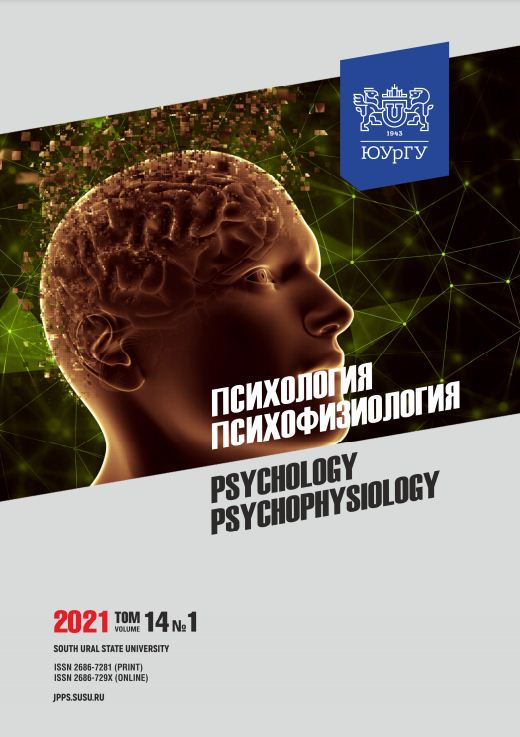RELATIONSHIP BETWEEN EMOTIONAL BURNOUT AND PSYCHOPHYSIOLOGICAL INDICATORS IN FIRE SERVICE EMPLOYEES
Abstract
Abstract. Diagnostics of psychoemotional state, as well as the development of a program for mental health recovery are essential for preventing the emotional burnout of fire service employees. Aim. The paper aims to find the relationship between emotional burnout and psychophysiological indicators of fire service employees to predict destructive manifestations. Materials and methods. The research was carried out on the basis of the 22nd Detachment of the Federal Fire Service in the Republic of Bashkortostan. The survey was conducted based on informed consent and involved 46 male firefighters divided into two age groups: from 20 to 35 years old (n = 26) and over 35 years old (n = 20). The following methods were used: psychodiagnostic techniques (Multipsychometer, DIP Scientific and Production Center, Moscow); simple visual-motor reaction (UPTF 1/30, Psychophysiologist, Mediсom MTD, Taganrog). Statistical processing was carried out using MS Excel and SPSS v. 23. Correlation analysis was performed using the Spearman correlation test. Results. Correlations were found between the phase of emotional burnout and the indicators of post-traumatic stress disorder, which had quantitative and qualitative differences depending on the age group. In employees of the younger age group, the integral indicator of emotional burnout was positively correlated with anxiety, uniqueness, inconsistency, social pessimism, memory for images, and negatively correlated with neurotic depression. Fire service employees over 35 years old showed correlations between the integral indicator of emotional burnout, neurotic depression (–) and memory for images (+). Conclusion. The data obtained are the basis for the development of algorithms for predicting destructive manifestations in fire service employees.
Downloads
References
2. Perelygin A.S., Khlopovskikh Yu.G. Stress resistance of employees of the fire service. Sovremennye tekhnologii obespecheniya grazhdanskoi oborony i likvidatsii posledstvii chrezvychainykh situatsii = Modern technologies for ensuring civil defense and eliminating the consequences of emergency situations. 2016; 1-2 (7): 315–319. (in Russ.). https://elibrary.ru/item.asp?id=26294785
3. Shlenkov A.V., Malygina E.A., Moskalenko G.V. Influence of negative occupational factors on individual personal characteristics of fire and rescuers. Pozharovzryvobezopasnost = Fire and explosion safety. 2017; 26 (10): 61–68. (in Russ.). DOI: 10.18322/PVB.2017.26.10.61-68
4. Savinkov S.N., Koval N.A. Concept of personal reliability of EMERCOM of Russia officials. Psikholog = Psychologist. 2019; 2: 37–45. (In Russ.). DOI: 10.25136/2409-8701.2019.2.29129
5. Saijo Y. Ueno T., Hashimoto Y. Twenty-four-hour Shift Work, Depressive Symptoms, and Job Dissatisfaction Among Japanese Firefighters. American journal of industrial medicine. 200; 51 (5): 380–391. DOI: 10.1002/ajim.20571.
6. Kimbrel N.A., Steffen L.E., Meyer E.C. et al. A revised measure of occupational stress for firefighters: Psychometric properties and relationship to posttraumatic stress disorder, depression, and substance abuse. Psychological Services. 2011; 8 (4): 294–306. DOI: 10.1037/a0025845
7. Saijo Y., Ueno T., Hashimoto Y. Post-traumatic stress disorder and job stress among firefighters of urban Japan. Prehospital and Disaster Medicine. 2012; 27 (1): 59–63. DOI: 10.1017/S1049023X12000222
8. Phelps S.M., Drew-Nord D.C., Neitzel R.L. et al. Characteristics and Predictors of Occupational Injury Among Career Firefighters. Workplace Health Saf. 2018; 66 (6): 291–301. DOI: 10.1177/2165079917740595
9. Antipova E.I., Shibkova D.Z. Assessment of Psychophysiological Status and Quality of Life of Social Work Specialists. Chelovek. Sport. Meditsina = Human. Sport. Medicine. 2017; 17 (2): 30–39. (in Russ.) DOI: 10.14529/hsm170203
10. Shirvanov A.A., Kamneva E.V. Professional factors of EMERCOM staff “burnout”. Nauchnye i obrazovatelnye problemy grazhdanskoi zashchity = Scientific and educational problems of civil protection. 2016; 2 (29): С. 105–108. (in Russ.). https://elibrary.ru/item.asp?id=26145993
11. Slabinsky V.Yu., Voishcheva N.M., Chekhlatyi E.I., Podsadnyi S.A. Professional burnout and time perception in posttraumatic stress disorder. Ekologiya cheloveka = Human Ecology. 2018; 2: 45–50. (In Russ.). https://elibrary.ru/item.asp?id=32412425
12. Vaulerin J., dArripe-Longueville F., Emile M., Colson S.S. Physical exercise and burnout facets predict injuries in a population-based simple of French career firefighters. Applied Ergonomics. 2016; 54: 131–135. DOI: 10.1016/j.apergo.2015.12.007
13. Smith N.D., Deloy D.M., Dyal M.-A., Huang G. Impact of work pressure, work stress and work-family conflict on firefighter burnout. International Archives of Occupational and Environmental Health. 2019; 74 (4). DOI: 10.1080/19338244.2017.1395789
14. Vodopyanova N.E., Starchenkova E.S. Burnout syndrome: diagnostics and prevention. St. Petersburg: Piter, 2008. 358 p. (in Russ.). https://elibrary.ru/item.asp?id=20093473
15. Khlopovskikh Yu.G., Kravtsov A.V. The syndrome of professional burnout in the activity of a rescue worker of the Ministry of Emergency Situations: causes, features and methods of overcoming. Pozharnaya bezopasnost: problemy i perspektivy = Fire safety: problems and prospects. 2015; 1 (6): 279–284. URL: https://elibrary.ru/item.asp?id=26741339
16. Sawhney G., Jennings K.S., Britt T.W., Sliter M.T. Occupational Stress and Mental Health Symptoms: Examining the Moderating Effect of Work Recovery Strategies in Firefighters. Journal of Occupational Health Psychology. 2018; 23 (3): 443–456. DOI: 10.1037/ocp0000091
17. Smith L.J., Bartlett B.A., Tran J.K. et al. Sleep Disturbance Among Firefighters: Understanding Associations with Alcohol Use and Distress Tolerance. Cognitive Therapy and Research. 2019; 43: 66–77. DOI: 10.1007/s10608-018-9955-0
References on translit
.Copyright (c) 2021 Psychology. Psychophysiology

This work is licensed under a Creative Commons Attribution-NonCommercial-NoDerivatives 4.0 International License.



